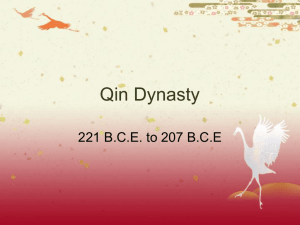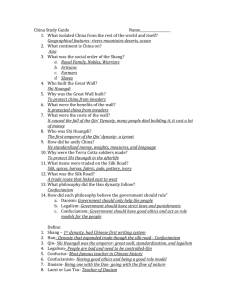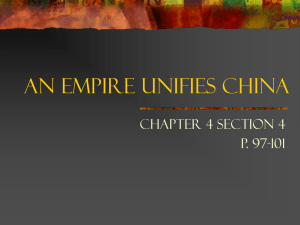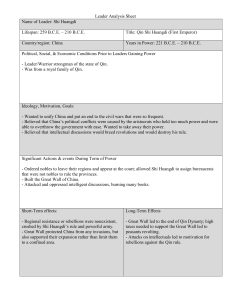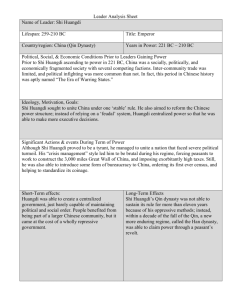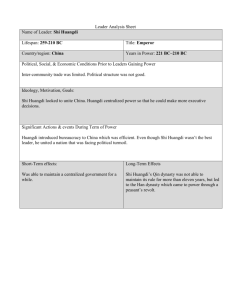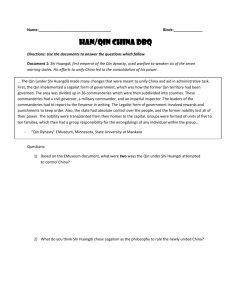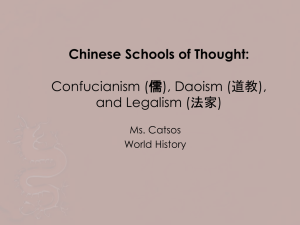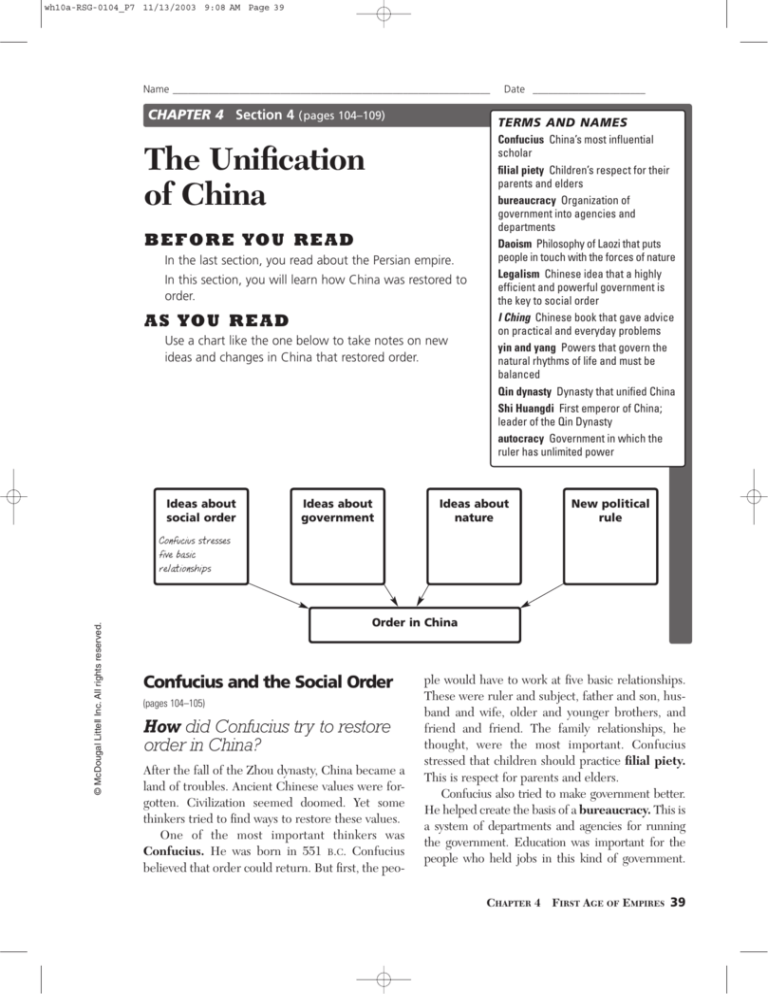
wh10a-RSG-0104_P7 11/13/2003 9:08 AM Page 39
Name ______________________________________________________________
CHAPTER 4 Section 4 (pages 104–109)
The Unification
of China
BEFORE YOU READ
In the last section, you read about the Persian empire.
In this section, you will learn how China was restored to
order.
AS YOU READ
Use a chart like the one below to take notes on new
ideas and changes in China that restored order.
Ideas about
social order
Ideas about
government
Date ______________________
TERMS AND NAMES
Confucius China’s most influential
scholar
filial piety Children’s respect for their
parents and elders
bureaucracy Organization of
government into agencies and
departments
Daoism Philosophy of Laozi that puts
people in touch with the forces of nature
Legalism Chinese idea that a highly
efficient and powerful government is
the key to social order
I Ching Chinese book that gave advice
on practical and everyday problems
yin and yang Powers that govern the
natural rhythms of life and must be
balanced
Qin dynasty Dynasty that unified China
Shi Huangdi First emperor of China;
leader of the Qin Dynasty
autocracy Government in which the
ruler has unlimited power
Ideas about
nature
New political
rule
© McDougal Littell Inc. All rights reserved.
Confucius stresses
five basic
relationships
Order in China
Confucius and the Social Order
(pages 104–105)
How did Confucius try to restore
order in China?
After the fall of the Zhou dynasty, China became a
land of troubles. Ancient Chinese values were forgotten. Civilization seemed doomed. Yet some
thinkers tried to find ways to restore these values.
One of the most important thinkers was
Confucius. He was born in 551 B.C. Confucius
believed that order could return. But first, the peo-
ple would have to work at five basic relationships.
These were ruler and subject, father and son, husband and wife, older and younger brothers, and
friend and friend. The family relationships, he
thought, were the most important. Confucius
stressed that children should practice filial piety.
This is respect for parents and elders.
Confucius also tried to make government better.
He helped create the basis of a bureaucracy. This is
a system of departments and agencies for running
the government. Education was important for the
people who held jobs in this kind of government.
CHAPTER 4 FIRST AGE OF EMPIRES 39
wh10a-RSG-0104_P8 11/13/2003 9:08 AM Page 40
Over time, the ideas of Confucius spread to other
countries of East Asia.
1. How did Confucius try to restore ancient Chinese
values?
Other Ethical Systems (pages 105–107)
What other ethical systems
developed?
Another thinker of this period was Laozi. He said
nature follows a universal force called the Dao, or
“the Way.” His beliefs are called Daoism.
Other thinkers formed a set of beliefs called
Legalism. They said the government should use
the law to restore order in China.
Some Chinese people looked for practical advice
in solving problems. They might refer to a book
called I Ching. Other people turned to the idea of
yin and yang. These two powers represented the
harmony between opposite forces in the universe.
2. What was the basic purpose of all these ethical
systems?
states. This young ruler used the ideas of Legalism to
unite China. After ruling for 20 years, he took a new
name—Shi Huangdi. This means “First Emperor.”
Shi Huangdi doubled the size of China. He
established an autocracy. In this kind of government, a ruler has unlimited power. Shi Huangdi
forced wealthy nobles to give up their land in the
country and move to his capital city. He destroyed
his enemies. The emperor wanted to control ideas,
too. He ordered his government to burn books.
Shi Huangdi also had peasants build a network
of roads that linked one corner of the empire to
another. He set standards for writing, law, money,
and weights and measures to be followed throughout the empire.
In the past, some Chinese rulers had built sections of wall to try to block attacks from northern
nomads. Shi Huangdi had hundreds of thousands
of poor people connect these sections of wall and
make a huge barrier. When finished, the Great
Wall of China stretched for thousands of miles.
These steps won the emperor little support.
When he died, his son took the throne. Just three
years into his reign, peasants revolted and managed
to overthrow the emperor. By 202 B.C., the Qin
dynasty had given way to the Han dynasty.
3. Name two changes that Shi Huangdi made.
The Qin Dynasty Unifies China
What happened during the Qin
Dynasty?
A 13-year-old ruler became ruler of the Qin
Dynasty. He ended the troubles of the warring
Legalism
Skillbuilder
• The natural order is
more important than the
social order
• A highly efficient and
powerful government is
the key to social order.
Use the chart to answer the questions.
• A universal force guides
all things.
• Punishments are useful to
maintain social order.
• Human beings should
live simply and in
harmony with nature.
• Thinkers and their ideas
should be strictly controlled
by the government.
Daoism
40 CHAPTER 4 SECTION 4
1. Which set of ideas places more importance
on social order?
2. In what ways are these ideas opposite?
© McDougal Littell Inc. All rights reserved.
(pages 107–109)

